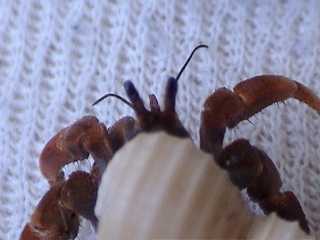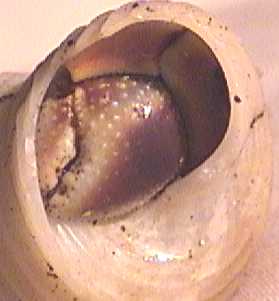 antennae! The body can be indian red, bluish or even
black!
antennae! The body can be indian red, bluish or even
black!
Coenobita
violascens
Reds!
Yes, they are red, or somewhat red. Actually, the reddest
thing on a Coenobita
violascens is it's fire-red  antennae! The body can be indian red, bluish or even
black!
antennae! The body can be indian red, bluish or even
black!
Coenobita violascens is a relatively new arrival in the U.S., and there has been a lot of speculation as to what species of crab this actually is! Leave it to long-time Landhermitcrabs.com member JediMasterThrash to finally get to the bottom of the mystery! JMT took the time to patiently observe all the characteristics and finally let us know that most of us were wrong -- what we thought was C. cavipes was in fact C. violascens! If you would like to read JMT's treatise on species, you can find it HERE.
Coenobita violascens was a relatively unknown species to U.S. crabbers before 2003. We had all seen pictures of C. brevimanus, C. perlatus and C. variabilis from Australia, but never the C. violascens. Everyone thought that they were all dramatically purple, but that is not always the case! To make things even more confusing, it appears that some Coenobita violascens crabs actually WERE imported into the United States and thus are in fact available as pets. I refer you to the link above and JediMasterThrash's excellent treatise on how to determine "who is who."
Special
Needs.
They need and love salt water! Especially right after
you bring them home from the pet store. They will drink it for hours
and hours! They also really enjoy digging. Not just to de-stress,
either. My "violas" stay buried in the Forest Bedding about 80% of the
time. Be sure you provide them with a substrate that facilitates a lot
of digging.
Molting.
C. violascens molts very well in sand
and Forest Bedding, all
of mine have molted in both and came up perfect. The general molting
method described on the Molting page works
well for other exotics so I suspect that C. violascens would find it
acceptable. When it comes to Violas' molting habits, they are very
similar to those of the purple pincher or Ecuadorian crabs. They will
dig under and molt and then come back up when they are ready.
Temperament.
The Violas that I own are very, very shy. They stay underneath
the substrate most of the time and  only come up at night to eat
and drink. They also don't like to change shells much. Each crab is
different, however, so yours might be more friendly. Some people have
mentioned that their Violas are very vocal, but I have never heard mine
vocalize. Then again, they are usually buried so I probably wouldn't
hear them even if they did. C. violascens is one of the least
aggressive of the species, as far as I can tell. They only want to bury
and be left alone.
only come up at night to eat
and drink. They also don't like to change shells much. Each crab is
different, however, so yours might be more friendly. Some people have
mentioned that their Violas are very vocal, but I have never heard mine
vocalize. Then again, they are usually buried so I probably wouldn't
hear them even if they did. C. violascens is one of the least
aggressive of the species, as far as I can tell. They only want to bury
and be left alone.
Compatibility.
I have been keeping my C. violascens crabs in a crabitat along with all
my Ecuadorians and other exotic species. They appear to get along well.
Keep an eye on the crabitat initially after introducing ANY new
species, to make sure there is no trouble.
Further
Research.
If you would like to view more pictures and
infomation about identifying this species of hermit crab, please check
out the Links page.
Home Page/ Behavior
& Aggression/Basic Care/Chirping/Convention
Happenings/ Sexing/FAQs/Food
& Feeding/My Links/Molting/Nocturnal
Behavior/Shells & Shell Pictures/Species Identification/About Me